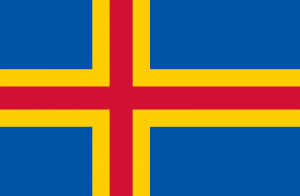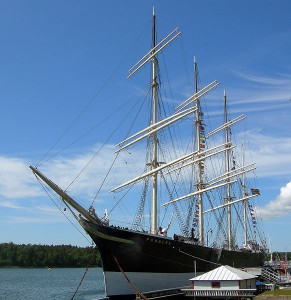Åland Islands

 Åland Islands Flag
Åland Islands Flag
The Åland Islands or Åland (Swedish: Åland, Swedish: [ˈoːland]; Finnish: Ahvenanmaa) is an autonomous, demilitarised, monolingually Swedish-speakingregion of Finland that consists of an archipelago lying at the entrance to the Gulf of Bothnia in the Baltic Sea. Collectively, the islands in the archipelago form the smallest region of Finland, constituting 0.49% of its land area and 0.50% of its population.
Åland comprises Fasta Åland (“Main Island”, on which 90% of the population resides) and a further 6,500 skerries and islands to its east. Fasta Åland is separated from the coast of Sweden by 38 kilometres (24 mi) of open water to the west. In the east, the Åland archipelago is contiguous with the Finnish Archipelago Sea. Åland’s only land border is located on the uninhabited skerry of Märket, which it shares with Sweden.
Åland’s autonomous status means that those provincial powers normally exercised by representatives of the central Finnish government are largely exercised by its own government.
Autonom – Special member state territories and the European Union
The autonomous status of the islands was affirmed by a decision made by the League of Nations in 1921 following the Åland crisis. It was reaffirmed within the treaty admitting Finland to the European Union. By law, Åland is politically neutral and entirely demilitarised, and residents are exempt from conscription to the Finnish Defence Forces. The islands were granted extensive autonomy by the Parliament of Finland in the Act on the Autonomy of Åland of 1920, which was later replaced by new legislation by the same name in 1951 and 1991. Åland remains exclusively Swedish-speaking by law.
In connection with Finland’s admission to the European Union, a protocol was signed concerning the Åland Islands that stipulates, among other things, that provisions of the European Community Treaty shall not force a change of the existing restrictions for foreigners (i.e., persons who do not enjoy “home region rights” (hembygdsrätt) in Åland) to acquire and hold real property or to provide certain services.
Etymology
Åland’s original name was in Proto-Norse language *Ahvaland which means “Land of Water”. In Swedish, this first developed into Áland and eventually into Åland, literally “river land”—even though rivers are not a prominent feature of Åland’s geography. The Finnish name of the island, Ahvenanmaa (“perch land”), is seen to preserve another form of the old name.
Another theory suggests that the Finnish Ahvenanmaa would be the original name of the archipelago, from which the SwedishÅland derives.
 The museum ship Pommern lies at anchor in Västerhamn, the more westerly of Mariehamn‘s two harbours.
The museum ship Pommern lies at anchor in Västerhamn, the more westerly of Mariehamn‘s two harbours.
The Åland Islands formed part of the territory ceded to Russia by Sweden under the Treaty of Fredrikshamn in September 1809. As a result, along with all other parts of Finland, they became part of the semi-autonomous Grand Duchy of Finland.
During this process, Sweden failed to secure a provision that the islands not be fortified. The issue was important not only for Sweden but also for the United Kingdom, which was concerned that a military presence on the islands could threaten Britain’s military and commercial interests.
In 1832, Russia started to fortify the islands with the great fortress of Bomarsund. A combined British and French force of warships and marines captured and destroyed the fortress in 1854 as part of the campaign in the Baltic during the Crimean War. The 1856 Treaty of Paris demilitarized the entire Åland Islands archipelago.
During the Finnish Civil War, in 1918, Swedish troops intervened as a peacekeeping force between the Russian troops stationed on the islands and “White” and “Red”Finnish troops who came from Finland over the frozen sea. (Historians point out that Sweden may have in reality planned to occupy the islands.) Within weeks, the Swedish troops gave way to German troops who occupied Åland by request of the “White” (conservative) Senate of Finland.
 Åland (blue) with historical and modern provinces of Finland (yellow) juxtaposed.
Åland (blue) with historical and modern provinces of Finland (yellow) juxtaposed.
After 1917 the residents of the islands worked towards having them ceded to Sweden. In 1919 a petition for secession from Finland and integration with Sweden was signed by 96.4% of the voters on the islands, with over 95% in favour, although serious questions later arose regarding this extraordinarily high figure. Swedish nationalist sentiments had grown strong particularly as a result of the following issues: anti-Swedish tendencies in Finland, Finnish nationalism fuelled by Finland’s struggle to retain its autonomy, and the Finnish resistance against Russification. In addition, the conflict between the Swedish-speaking minority and the Finnish-speaking majority (on the mainland), which since the 1840s had been prominent in Finland’s political life, contributed to the Åland population’s apprehension about its future in Finland.
Finland, however, declined to cede the islands and instead offered them an autonomous status. Nevertheless the residents did not approve the offer, and the dispute over the islands was submitted to the League of Nations. The latter decided that Finland should retain sovereignty over the province but that the Åland Islands should be made an autonomous territory. Thus Finland was obliged to ensure the residents of the Åland Islands the right to maintain the Swedish language, as well as their own culture and local traditions. At the same time, an international treaty established the neutral status of Åland, prohibiting the placing of military installations or forces on the islands.
In the course of the 20th century, increasing numbers of the islanders have perceived Finnish sovereignty as benevolent and even beneficial. The combination of disappointment about insufficient support from Sweden in the League of Nations, Swedish disrespect for Åland’s demilitarized status in the 1930s, and some feelings of a shared destiny with Finland during and after World War II has changed the islanders’ perception of Åland’s relation to Finland from “a Swedish province in Finnish possession” to “an autonomous part of Finland”. The islanders enjoyed safety at sea during World War II, as their merchant fleet sailed for both the allied countries and the Germans. Consequently Åland shipping was not generally attacked as each side rarely knew which cargo was being carried to whom.
 Euro coin commemorating the 150th anniversary of the demilitarisation of the islands.
Euro coin commemorating the 150th anniversary of the demilitarisation of the islands.
Finland marked the 150th anniversary of demilitarisation of the Åland Islands by issuing a high-value commemorative coin, the €5 150th Anniversary of Demilitarisation of Åland Islands commemorative coin, minted in 2006. The obverse depicts a pine tree, very typical in the Åland Islands. The reverse design features a boat’s stern and rudder, with a dove perched on the tiller, a symbol of 150 years of peace.

